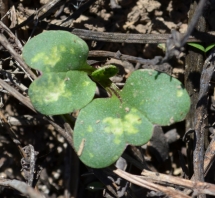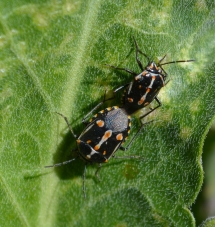Overview
Lepidium latifolium (perennial pepperweed; Brassicaceae) is an especially abundant weed in disturbed riparian systems throughout western North America, including the Santa Clara River valley of Ventura County, and often invades adjacent agricultural fields via seed or rhizomes by following drainage ditches and canals (Young et al. 1995). We recently found bagrada bugs (Bagrada hilaris) feeding on and causing severe damage to L. latifolium and Hirschfeldia incana (short pod mustard) in riparian areas of Ventura County. The numerical response of B. hilaris on L. latifolium and to a lesser extent on H. incana, may pose a significant challenge to effectively managing pest populations in crops. These plant species may act as source populations for establishment of bugs in cropping systems and re-infestation after control has been implemented.
The Bargada bug, Bagrada hilaris, (Hemiptera: Pentatomidae) was first detected in Los Angeles, California, in 2008, and is rapidly expanding across the southwest US (Arakelian 2008, Bundy et al. 2012). Herbivory causes severe damage to plants in the mustard (Brassicaceae) family, but insects can be found on other unrelated crops without any observed damage (Palumbo 2010). This pest often reaches outbreak levels on cole crops in its native range in Africa, the Mediterranean region, and across the Indian subcontinent (Hill 1975, Daiber 1992), a trend that has extended to the United States. Feeding in row crops has been observed to occur mostly on new growth, causing deformities, chlorotic spots on leaves, and stunting growth, and damage can result in unmarketable produce. In Ventura County, this species is especially damaging to organically grown crops where infestations often cause complete crop losses (Lawrence 2012). Establishment of this new pest in the region has necessitated increased pesticide use in cole crops, and in some cases, caused farmers to stop growing these varieties altogether (J. Berk, San Miguel Produce).
Potential Control
Controlling weed populations in agricultural areas should be a priority, but control is difficult and mechanical methods such as mowing or disking can produce vegetative fragments that facilitate spread. Development of integrated pest management methods, such as use of trap crops and biological control, will be important tools for controlling this insect pest and weed populations while alleviating the need to increase pesticide use on cole crops.


 Perennial pepperweed seedlings with bagrada bug feeding damage
Perennial pepperweed seedlings with bagrada bug feeding damage Bagrada bug mating pair on perennial pepperweed
Bagrada bug mating pair on perennial pepperweed